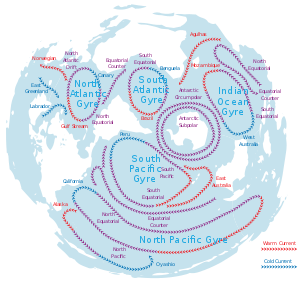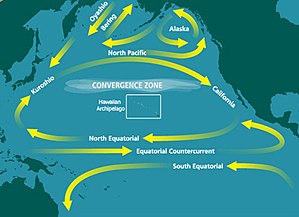The Great Pacific garbage patch, also described as the Pacific trash vortex, is a gyre of marine debris particles in the central North Pacific Ocean discovered between 1985 and 1988. It is located roughly between 135°W to 155°W and 35°N and 42°N. The patch extends over an indeterminate area of widely varying range depending on the degree of plastic concentration used to define the affected area.
The patch is characterized by exceptionally high pelagic concentrations of plastic, chemical sludge, and other debris that have been trapped by the currents of the North Pacific Gyre. Its low density (4 particles per cubic meter) prevents detection by satellite imagery, or even by casual boaters or divers in the area. It consists primarily of a small increase in suspended, often microscopic, particles in the upper water column.
The Patch is created in the gyre of the North Pacific Subtropical Convergence Zone
The great Pacific garbage patch was described in a 1988 paper published by the National Oceanic and Atmospheric Administration (NOAA) of the United States. The description was based on results obtained by several Alaska-based researchers in 1988 that measured neustonic plastic in the North Pacific Ocean. Researchers found relatively high concentrations of marine debris accumulating in regions governed by ocean currents. Extrapolating from findings in the Sea of Japan, the researchers hypothesized that similar conditions would occur in other parts of the Pacific where prevailing currents were favorable to the creation of relatively stable waters. They specifically indicated the North Pacific Gyre.
Charles J. Moore, returning home through the North Pacific Gyre after competing in the Transpacific Yacht Race in 1997, claimed to have come upon an enormous stretch of floating debris. Moore alerted the oceanographer Curtis Ebbesmeyer, who subsequently dubbed the region the “Eastern Garbage Patch” (EGP). The area is frequently featured in media reports as an exceptional example of marine pollution.
The patch is not easily visible, because it consists of tiny pieces almost invisible to the naked eye. Most of its contents are suspended beneath the surface of the ocean, and the relatively low density of the plastic debris is, according to one scientific study, 5.1 kilograms per square kilometer of ocean area (5.1 kg/km2).
A similar patch of floating plastic debris is found in the Atlantic Ocean, called the North Atlantic garbage patch.

It is thought that, like other areas of concentrated marine debris in the world’s oceans, the Great Pacific garbage patch formed gradually as a result of ocean or marine pollution gathered by ocean currents. The garbage patch occupies a large and relatively stationary region of the North Pacific Ocean bound by the North Pacific Gyre (a remote area commonly referred to as the horse latitudes). The gyre’s rotational pattern draws in waste material from across the North Pacific Ocean, including coastal waters off North America and Japan. As material is captured in the currents, wind-driven surface currents gradually move floating debris toward the center, trapping it in the region.
There is no strong scientific data concerning the origins of pelagic plastics. In a study published in 2014, researchers sampled 1571 locations throughout the worlds oceans, and determined that discarded fishing gear such as buoys, lines, and nets accounted for more than 60% of the mass of plastic marine debris. According to a 2011 EPA report, “The primary source of marine debris is the improper waste disposal or management of trash and manufacturing products, including plastics (e.g., littering, illegal dumping) … Debris is generated on land at marinas, ports, rivers, harbors, docks, and storm drains. Debris is generated at sea from fishing vessels, stationary platforms, and cargo ships.” Pollutants range in size from abandoned fishing nets to micro-pellets used in abrasive cleaners. Currents carry debris from the west coast of North America to the gyre in about six years, and debris from the east coast of Asia in a year or less.
A 2017 study conducted by scientists from the University of California, Santa Barbara, and the University of Georgia, concluded that of the 9.1 billion tons of plastic produced since 1950, close to 7 billion tons are no longer in use. The authors estimate that only 9 percent got recycled over the years, while another 12 percent was incinerated, leaving 5.5 billion tons of plastic waste littering the oceans and land.
Another recent Australian study focused on the high rate of seafloor plastic pollution, thereby highlighting an often overlooked aspect of oceanic plastic pollution. The researchers from the Institute for Marine and Antarctic Studies at the University of Tasmania stated that “while the huge volume of plastic debris accumulating in the world’s oceans and on beaches has received global attention, the amount of plastic accumulating on the seafloor is relatively unknown.”
Estimates of size
The size of the patch is unknown, as is the precise distribution of debris, because large items readily visible from a boat deck are uncommon. Most debris consists of small plastic particles suspended at or just below the surface, making it difficult to accurately detect by aircraft or satellite. Instead, the size of the patch is determined by sampling. Estimates of size range from 700,000 square kilometres (270,000 sq. mi) (about the size of Texas) to more than 15,000,000 square kilometres (5,800,000 sq. mi) (0.4% to 8% of the size of the Pacific Ocean). Such estimates, however, are conjectural given the complexities of sampling and the need to assess findings against other areas. Further, although the size of the patch is determined by a higher-than-normal degree of concentration of pelagic debris, there is no standard for determining the boundary between “normal” and “elevated” levels of pollutants to provide a firm estimate of the affected area.
Photodegradation of plastics
Some plastics decompose within a year of entering the water, leaching potentially toxic chemicals such as bisphenol A, PCBs, and derivatives of polystyrene.
The process of disintegration means that the plastic particulate in much of the affected region is too small to be seen. In a 2001 study, researchers (including Charles Moore) found concentrations of plastic particles at 334,721 pieces per km2 with a mean mass of 5,114 grams (11.27 lbs) per km2, in the neuston. Assuming each particle of plastic averaged 5 mm × 5 mm × 1 mm, this would amount to only 8 m2 per km2 due to small particulates. Nonetheless, this represents a high amount with respect to the overall ecology of the neuston. In many of the sampled areas, the overall concentration of plastics was seven times greater than the concentration of zooplankton. Samples collected at deeper points in the water column found much lower concentrations of plastic particles (primarily monofilament fishing line pieces).
Effect on marine life and humans
Some of these long-lasting plastics end up in the stomachs of marine animals, and their young, including sea turtles and the black-footed albatross. Midway Atoll receives substantial amounts of marine debris from the patch. Of the 1.5 million Laysan albatrosses that inhabit Midway, nearly all are likely to have plastic in their digestive system. Approximately one-third of their chicks die, and many of those deaths are due to being fed plastic by their parents. Twenty tons of plastic debris washes up on Midway every year with five tons of that debris being fed to albatross chicks.
Besides the particles’ danger to wildlife, on the microscopic level the floating debris can absorb organic pollutants from seawater, including PCBs, DDT, and PAHs. Aside from toxic effects, when ingested, some of these are mistaken by the endocrine system as estradiol, causing hormone disruption in the affected animal. These toxin-containing plastic pieces are also eaten by jellyfish, which are then eaten by fish.
Many of these fish are then consumed by humans, resulting in their ingestion of toxic chemicals. While eating their normal sources of food, plastic ingestion can be unavoidable or the animal may mistake the plastic as a food source.
Marine plastics also facilitate the spread of invasive species that attach to floating plastic in one region and drift long distances to colonize other ecosystems. Research has shown that this plastic marine debris affects at least 267 species worldwide.
The United Nations Ocean Conference estimated that the oceans might contain more weight in plastics than fish by the year 2050.



